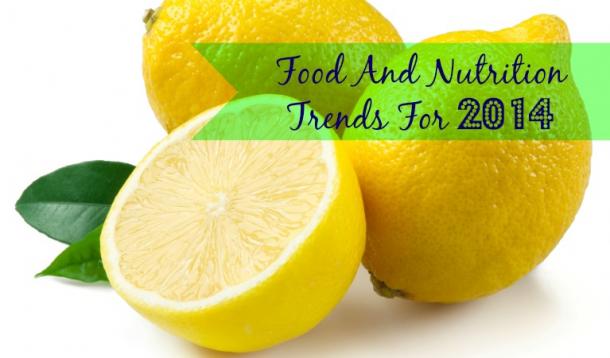
I always like to be on top of food and nutrition trends and while doing research to find out what's hot for 2014, I was pleasantly surprised to find that most, if not all of the predicted trends are steering us in the right direction nutrition-wise. I was very happy to see that people are turning to organic, local and non-GMO foods more often and that convenience processed and packaged foods are being traded in for whole fresh foods. Kids nutrition steps into the spotlight (which I am thrilled about), especially when it comes to restaurants and fast food chains. And it is not surprising that more gluten-free options are popping up as well, as the trend away from gluten—which we have seen in the past few years—will continue into 2014.
I absolutely love lemon. Whether you're using the zest or the juice, lemon adds a freshness and tang to any dish and brightens up any meal. This simple and often underappreciated citrus fruit is naturally detoxifying and is a great source of Vitamin C. According to the Sterling-Rice group, lemon will be the "flavour of the year" and you'll likely see lemon as a preserve, added to yogurt and as the main pastry ingredient. Try out this Lemony Broccoli recipe — you will not be disappointed!
With more people being diagnosed with Celiac Disease, wheat allergies and Non-Celiac Gluten Sensitivity, it is no wonder that gluten/wheat-free foods are becoming more popular and plentiful. Although the gluten-free diet has become more of a fad than anything, often mistaken as a weight loss diet or as a miracle solution to whatever ails us, I'm happy to see that those who genuinely need to steer clear of gluten and wheat have more options. A few years ago, the gluten-free pasta options were very limited, but today, non-wheat based pastas are becoming available such as quinoa pasta, corn pasta, buckwheat pasta and rice pasta. I'm happy to see the trend towards higher fibre gluten-free pastas (such as buckwheat and quinoa) as many gluten-free grains starch options offer little to no fibre.
Hooray! Egg yolks have finally made a come-back after many years of thinking that they raised blood cholesterol levels and caused heart disease (which they do not). Gone are the days of egg white omelettes, as we welcome yolks back with open arms—and mouths. The yolk houses most of the egg's nutrition, including protein and a variety of vitamins and minerals such as Iron, Vitamins A, D, E and B12, Folate, Selenium, Lutein, Zeaxanthin, and Choline, which are all important nutrients for optimal health. In the culinary world, chefs will be experimenting with egg yolks by using them in place of cheese, cream and other dairy to add richness to dishes and create sauces.
Thankfully, the trend towards healthier foods for babies and children continues to grow in restaurants and among food manufacturers. A variety of organic nutrient-rich baby and toddler foods have made their way into most major grocery stores, and restaurants as well as fast food chains have started offering healthier kids' meals, complete with fresh fruits and vegetables, milk and whole grains.
The trend towards buying local and organic foods continues to grow, but what I'm seeing more buzz around is the non-GMO movement. Genetically Modified Organisms are organisms (like seeds) that have had their genes (DNA) altered in a way that is not natural and/or contains genes from another organism. For example, some genetically modified soybeans contain a gene that allows the soybean to grow well even when it has been sprayed by an herbicide. And some genetically modified corn contains a gene that produces a toxin that kills off a certain type of insect so that the corn does not become damaged. The problem is, that there isn't enough research to show what kind of negative long-term effects GMO's have on humans, so many people (including myself) try to avoid GMO foods as much as possible. Look for foods that have the Non-GMO project label on them to make sure that they have do not contain GMO's.
Seaweed has been an underconsumed nutritional treasure. All sea vegetables are great low-calorie sources of most B vitamins, calcium, iodine, magnesium, manganese, potassium, zinc, and vitamins A, C, and K. Most varieties also contain large amounts of lignans (the cancer and heart-disease preventing compounds found in flaxseeds) as well as potent antioxidants and phytochemicals. As a bonus, seaweed is also a great vegetarian source of EPA nad DHA (Omega-3 fatty acids) which are essential to our health. You will now find that seaweed extends beyond sushi and miso soup, and is now offered as a healthy snack (dried nori strips), as one of the main ingredients in soups and salads, and as an umami seasoning in many dishes.
Snacks made from whole, nutritionally dense ingredients are all the rage, such as dried and naturally-flavoured chickpeas, seaweed snacks, exotic-flavoured hummus and snacks made with seeds like chia, flax and hemp. Consumers are asking for healthier options that are still convenient and food manufacturers are listening. This is great news. We all know that a good old fresh piece of fruit with some nuts is likely a better option than any packaged food, but a healthy packaged food is better than an unhealthy packaged food. Although these more healthful options are now out there, continue to be weary of food labels and claims. "Fat-free" or "Source of fibre" does not mean "healthy." Always read the ingredients list (which is way more important than the nutrition facts table, in my opinion). If the ingredients list is long and you don't recognize most of the ingredients, put it back on the shelf!